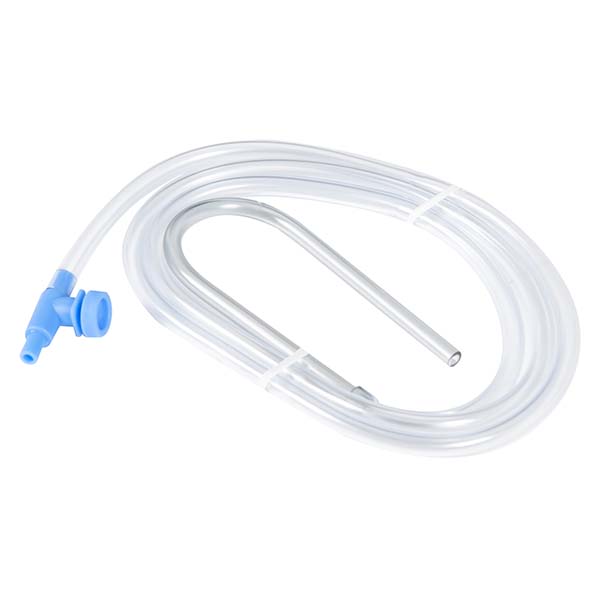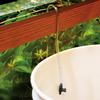Contents:
1 – rigid U-tube
1 – flow control valve
36" flexible tubing
Kit Assembly Unit comes preassembled.
- Rinse thoroughly with clean tap water before use.
- Place rigid tubing over lip of aquarium so the control valve dangles freely outside the aquarium. Make sure the rigid tubing end is underwater.
- Fully open valve counterclockwise until you can easily start a siphon by sucking on end of valve.
- When siphon starts, adjust drip rate to 2-4 drops per second. This may be adjusted to accommodate larger fish in larger volumes of water. Turn the valve counterclockwise to increase drip rate or clockwise to decrease drip rate. Remember to double the volume of water in about 1/2-1 hour while never taking more than 2 hours total time for acclimation.
Drip Acclimation Method
This method is considered more advanced then other methods. It is geared toward sensitive inhabitants such as snails, corals, shrimp, sea stars, wrasses, and discus. You need the LiveAquaria Drip Acclimation Kit and must be willing to monitor the entire process. Gather a clean, 3- or 5-gallon bucket designated for aquarium use only. If acclimating both fish and invertebrates, use a separate bucket for each.
- Turn off aquarium lights.
- Dim the lights in the room where your specimen bags will be opened. (Severe stress or trauma may result from sudden exposure to bright light.)
- Float the sealed bag in your aquarium for 15 minutes (Fig. A). This allows the water in the specimen bag to adjust slowly to the temperature in the aquarium.
-
Carefully empty the contents of the bags (including the water) into the buckets (Fig. B), making sure not to expose sensitive invertebrates to the air. Depending on the amount of water in each bag, this may require tilting the bucket at a 45-degree angle to make sure the animals are fully submerged (Fig. C). You may need a prop or wedge to help hold the bucket in this position until there is enough liquid in the bucket to put it back to a level position.
-
Use the LiveAquaria Drip Acclimation Kit to set up and run a siphon drip line from the main aquarium to the bucket. You'll need separate kits for each bucket used. The rigid tubing will sit over the trim of most glass aquariums. Use the enclosed valve to regulate flow from the aquarium into the bucket.
- Begin a siphon by sucking on the end of the airline tubing you'll be placing into the bucket. When water begins flowing through the tubing, adjust the drip by adjusting the control valve to a rate of about 2-4 drips per second (Fig. D).
- When the water volume in the bucket doubles, discard half and continue the acclimation process until the volume doubles once more – about one hour.
- At this point, the specimens can be transferred to the aquarium. (Fig. E) Sponges, clams, and gorgonians should never be directly exposed to air. Gently scoop them out of the drip bucket with the specimen bag, making sure they're fully covered in water. Submerge the bag underwater in the aquarium and gently remove the specimen from the bag. Next, seal off the bag underwater by twisting the opening, and remove it from the aquarium. Discard both the bag and the enclosed water. A tiny amount of the diluted water will escape into the aquarium; this is okay. Also, to avoid damage, please remember never to touch the "fleshy" part of live coral when handling.
Important Tips
- Be patient – never rush the acclimation procedure. The total acclimation time for your new arrival should take no longer than two hours.
- Always follow the acclimation procedure even if your new arrival appears to be dead. Some fish and invertebrates can appear dead when they arrive and will usually revive when the acclimation procedure is followed correctly.
- Never place an airstone into the shipping bag or bucket when acclimating your new arrival. This will increase the pH of the shipping water too quickly and expose your new arrival to lethal ammonia.
- Keep aquarium lights off for at least four hours after the new arrival is introduced into the aquarium.
- Most invertebrates and marine plants are more sensitive than fish to changes in specific gravity. Please acclimate invertebrates to a specific gravity of 1.023-1.025 or severe stress or trauma may result.
- Some live corals produce excess slime when shipped. After the acclimation procedure is followed, hold the coral by the rock or skeletal base and gently shake the coral in the shipping bag before placing into the aquarium. To avoid damage, please remember never to touch the "fleshy" part of a live coral. Many species of coral will not open for several days after introduction into their new home.
- In some instances, a new tank mate will be chased and harassed by one or all of your existing tank mates.
Solution 1: A clean plastic spaghetti strainer (found at your local discount store) can be
used to contain a tank bully within the aquarium for several hours until the new arrival adjusts to its surroundings. Just float the perforated plastic basket in the aquarium. Net the tank bully and place in the floating basket for approximately four hours while the new arrival adjusts to your aquarium. Never place the new arrival in this basket; the new specimen must get familiar with your aquarium. By placing the tank bully in a perforated basket, you'll reduce the stress on the new arrival.
Solution 2: A perforated plastic lighting grid can be purchased at the local hardware store to cut down the width of your aquarium. This grid may be used to section off a small portion of the aquarium to separate territorial or aggressive fish from the newest tank mate. After the new addition adjusts to the unfamiliar environment, the divider can be removed.
|









